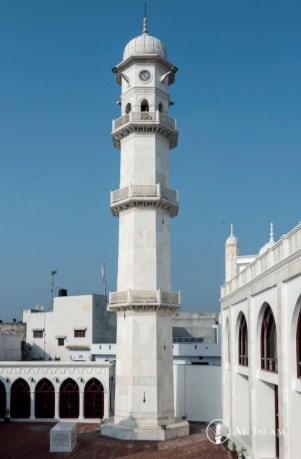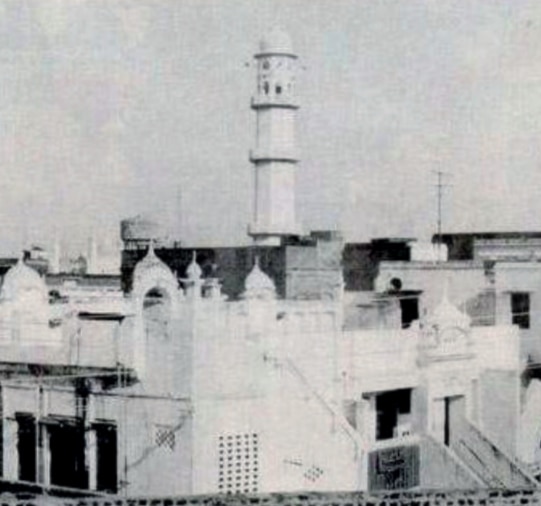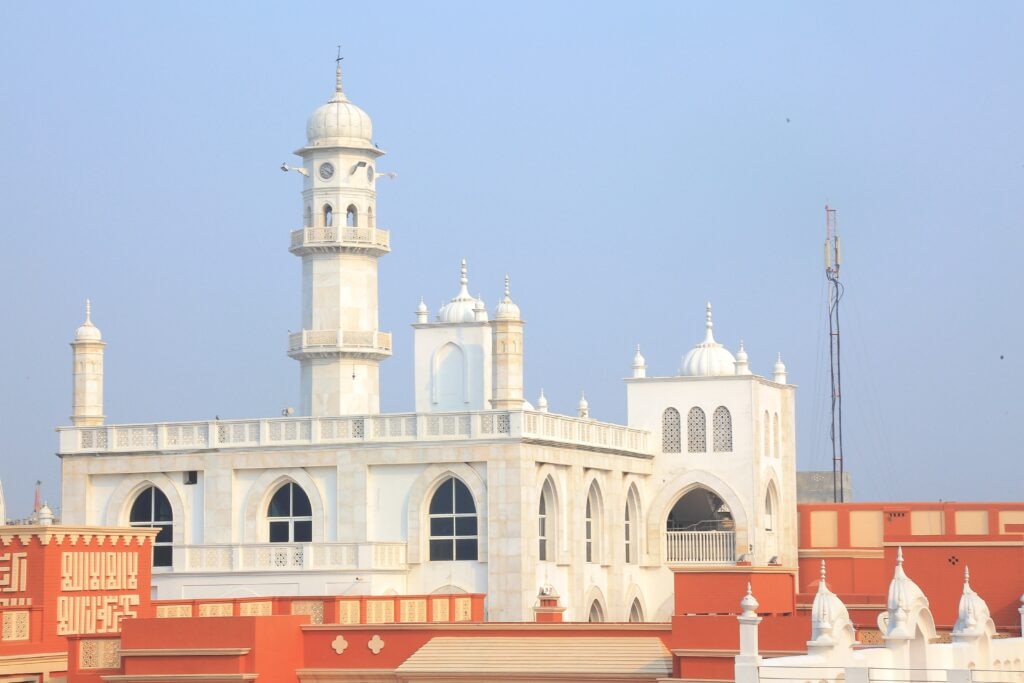Mohammad Mufleh Ahmad, Student of Jamia Ahmadiyya Canada

A history of the White Minaret
The Holy Prophetsa mentioned many signs in regard to the advent of the Promised Messiahas. One such sign was the appearance of the Promised Messiahas near a white minaret to the east of Damascus.
بَعَثَ اللّٰهُ الْمَسِيحَ ابْنَ مَرْيَمَ فَيَنْزِلُ عِنْدَ الْمَنَارَةِ الْبَيْضَاءِ شَرْقِيَّ دِمَشْقَ
“Allah would send Jesus, son of Mary, and he will descend at the white minaret to the east of Damascus.” (Sahih Muslim, Kitab al-Fitan, Hadith 2937)
This hadith is often misunderstood by many non-Ahmadi Muslims. Their point of view is that the Promised Messiah would descend near a white minaret that would be on the eastern side of Damascus, meaning that the minaret would be within the city itself. So, to fulfil this prophecy, a minaret was built in 1069 on the eastern side of the city of Damascus in the Great Umayyad Mosque. The cost of construction was estimated to be “hundreds of thousands of dinars.” (Tarikh-e-Ahmadiyyat, Vol. 2, p. 114)
A few hundred years later, in April of 1340, Christians set fire to the Great Umayyad Mosque, which resulted in the minaret burning to the ground. (Ibid) A new base was set for the minaret at the same spot and was completed in 1372-73. (Ibid) Just 30 years later, in 1400, the Great Umayyad Mosque caught fire once again and despite best efforts, the mosque and the newly built minaret burned down. Soon after, in 1402, the governor of Syria, started the renovation of the mosque, which included the renovation of the Minaret of Jesus. (Ibid)
The reality of “…to the east of Damascus”
The construction of the Minaret of Jesus in Damascus without anyone claiming to be the Promised Messiah (within Damascus) demonstrates that the Muslims believed that the nuzul [descent] would be within the city of Damascus. This belief has proven to be a mistake, and what has actually turned out to be the case is that this only meant that the nuzul would be somewhere to the east of Damascus, meaning anywhere (regardless of country, culture or nation) that is east of Damascus. This interpretation is not only held by Ahmadi Muslims, but also by eminent scholars of the past, such as Imam Jalal ad-Din as-Suyutirh. (Tarikh-e-Ahmadiyyat, Vol. 2, p. 115)
Regarding this, the Promised Messiahas stated:
“In some of the ahadith, it is mentioned that the Messiah would descend near a minaret which is located to the east of Damascus. Hence, this hadith is not contradictory to our interpretation, since we have stated many times that our town, that is Qadian, and this mosque of ours is situated to the east of Damascus, near which a minaret will be erected. The hadith does not mention the details as to whether that minaret would be affiliated to or a part of Damascus, rather that it would be located to the east of it.” (Majmu‘a-e-Ishtiharat [1986], Vol. 3, p. 286, footnote)
Intention to construct Minarat-ul Masih
بخرام كه وقت تو نزديك رسيد و پائے محمديان بر منار بلند تر محكم افتاد
“Now come forward and go forth, as your time is near. The time is now coming that the people of Muhammad will be lifted from the pit and their steps will be planted firmly on a strong tower.” (Barahin-e-Ahmadiyya [English], Vol. 4, p. 401)
These were the words revealed to the Promised Messiahas while he was writing his book Barahin-e-Ahmadiyya. They clearly point towards the idea that the Promised Messiahas would have something to do with a minaret or a tower, although it was probably not clear at the time as to whether this was a physical or spiritual tower.
In May 1900, the Promised Messiahas expressed his intention of constructing a minaret called “Minarat-ul-Masih” in the courtyard of the Aqsa Mosque in Qadian, to also fulfil the grand prophecy of the white minaret in a physical or literal sense. On 28 May 1900, Huzooras published an announcement [ishtihar] detailing the importance of fulfilling this prophecy and calling the attention of Ahmadis towards the funding for the construction of this minaret. At that time, the Jamaat’s financial situation was not very strong. There were matters that required funding, like tabligh [preaching] and the number of Jamaat members was not very high at the time. Hazrat Mir Hissam-ud-Dinra estimated the cost for the construction of the minaret to be above 10,000 rupees.(Tarikh-e-Ahmadiyyat, Vol. 2, p. 115).
In the ishtihar, the Promised Messiahas also detailed his objectives for the minaret. Firstly, that the muezzin would call the azan for all five daily prayers. This would proclaim to the world that there is only one God, and He alone is worthy of worship and that He is alive and still shows signs. Secondly, bright lamps would be placed on the top of the minaret, which would signify the dispelling of darkness and the enlightening of the world. The lights would also be symbolic of the age of spiritual and heavenly light and spiritual advancement. Lastly, a clock would be placed at the top. It would strike at the top of every hour for the benefit of the people. It would indicate that in the present time the doors of heaven are still open and that there is no need for any war with the sword. (Majmu‘a-e-Ishtiharat [1986], Vol. 3, pp. 283-284)
Opposition to the construction of Minarat-ul-Masih
The pure intentions of the Promised Messiahas were opposed regarding the construction of Minarat-ul-Masih. The opponents of the Jamaat were quick to take this opportunity and attack Huzooras. They alleged that the Promised Messiahas was wasting money on a minaret. In response to these allegations, the Promised Messiahas published an ishtihar on 1 July 1900, and stated that the money was not being wasted on the minaret because its construction would fulfil a prophecy of the Holy Prophetsa. The Promised Messiahas also said that the clock would tell the time for the people, and help them be punctual for prayers, therefore, this would not be a bad thing at all.
Sacrifices made by Ahmadis for Minarat-ul-Masih
The Promised Messiahas decided to divide the estimated cost of 10,000 rupees into 100 rupees per person (Al Fazl, 26 January 1920), and the people who donated 100 rupees would have their names engraved on the minaret. Immediately after this announcement was made, four people, namely Hazrat Munshi Abdul Aziz Aujlawira, Hazrat Mian Shadi Khanra, Maulvi Muhammad Ali Sahib M.A. and Sheikh Niyaz Ahmad Sahib immediately paid the prescribed amount. (Tarikh-e-Ahmadiyyat, Vol. 2, p. 117) Hazrat Amma Jan, Sayyidah Nusrat Jehan Begumra, pledged 1000 rupees, which she fulfilled by selling one of her own properties in Delhi. (Ibid)

Initial arrangements for construction
By the end of 1901, the blueprints for the construction of Minarat-ul-Masih had been completed by Hazrat Sayyid Abdur Rashidra and the bricks had also been prepared. The land for the preparation of the bricks was given by Hazrat Mian Imam Dinra of Qadian. (Ibid) Hazrat Khalifatul Masih Ira requested that his own house may serve as the location for the Minarat-ul-Masih, but the Promised Messiahas decided that the Minarat-ul-Masih be constructed in the Aqsa Mosque. (Ibid)
The construction workers were from Sialkot and as a result of the plague, they were unable to travel to Qadian causing a delay in the construction.
Complaint about the construction of Minarat-ul-Masih
Hindus, Sikhs and Muslims, including government officials, took counsel amongst themselves and made it a common cause to oppose the Promised Messiah’sas plan of constructing the minaret:
“When the work of excavating the foundations was nearing completion, a police official came to Qadian from Batala on his round and sent a secret report, dated 6-3-1903, against the construction of the proposed Minaret.” (Life of Ahmad, p. 774)
Foundation of Minarat-ul-Masih
On 13 March 1903, after the Jumu‘ah prayer, Hazrat Hakim Fazl Ilahira and some other companions suggested that the Promised Messiahas lay the foundation of the minaret himself. The Promised Messiahas said, “You bring a brick, and I will pray upon it, and where I tell you to place it, you place it.” So, then Hazrat Hakim Fazl Ilahira brought a brick, Huzooras placed it on his thigh and prayed for a long while and then blew on the brick and gave it to Hazrat Hakim Fazl Ilahira and said to place the brick in the west side of the foundation of the minaret. On the way to the minaret, Hazrat Maulvi Abdul Karim Sialkotira also prayed on the brick. Hazrat Mir Nasir Nawabra was placed in-charge of the construction. (Tarikh-e-Ahmadiyyat, Vol. 2, p. 118)
Complaint about Minarat-ul-Masih continued
On 17 April 1903, Buddha Mal, Ghanayya Lal, Bur Singh Narain and Dasawar Singh complained to the authorities that the minaret would be used to look into the houses of the neighbours to spy on them, breaching their privacy. Then, only ten days later, Buddha Mal, Hukam Chand, Labhu Ram, Salig Ram, Mirza Ali Sher Baig and Mirza Imam Din again complained to the authorities about the construction of the minaret. Imam Din presented the idea that since the mosque is a public place and the minaret is a private structure, its construction was impeding their rights. On this day, the tehsildar of Batala asked the Promised Messiahas about the minaret and so Huzooras wrote to him in reply to the allegations, saying that all the people of Qadian knew the minaret was to be built in the mosque and that the complaint was only made due to personal enmity. The Promised Messiahas said that the building did not interfere with anyone’s purdah [privacy]. Moreover, there would not be even enough space at the top of the minaret for anyone to remain there and spy. And in this area, there would already be buildings of the height of minarets and people would be living in them; hence, there should be no reason for any complaint, otherwise, the same complaint could be made about them (27 such people were named). (Life of Ahmad, pp. 775-776)
Hazrat Mirza Bashir Ahmad MAra narrated that during a meeting with the magistrate, the Promised Messiahas pointed to Buddha Mal (a Hindu Arya Samajist who lived in Qadian and was of an extremist disposition and was opposing the construction of Minarat-ul-Masih) and said, “Here is Lala Buddha Mal, please ask him if there has been any occasion where I could be of any service to him but failed to oblige him; and whether there ever has been any occasion when he had the opportunity to harm me but he refrained from doing so.” Buddha Mal hung his head out of embarrassment and shame, and did not have any courage to respond to Huzooras. (Seerat-e-Tayyaba, pp. 58-59)

Opposition persists
On 1 May 1903, Mirza Nizam Din wrote to the authorities saying that the Promised Messiahas was laying the foundation for a new religion. Nizam Din claimed that the minaret was being erected simply to take possession of the mosque and he added that if the building would collapse, people would be hurt and hence there would be a danger of a breach of the peace.
Then just a week later, on 8 May, the tehsildar of Batala, Moti Ram, came to Qadian for inquiries. He was acting suspiciously, so on 9 May 1903, a memorial with the signatures of 30 Ahmadis was sent to him.
Then on 10 May, the Promised Messiahas again addressed the tehsildar and presented around fifteen points that refuted the allegations that were being made by the opponents. (Life of Ahmad, p. 777-781)
The verdict
Despite all these proofs, on 12 May 1903, tehsildar Moti Ram made a negative report to the deputy commissioner. However, by the grace of God, the Deputy Commissioner was an intelligent man. He understood the situation and on 13 May, decided that the construction of the minaret was not a threat to the peace in Qadian. He stated that “if anyone is grieved or offended by the construction, then they should resort to civil proceedings.” (Ibid, pp. 781-782)
Pause in construction
There was no longer anything stopping the construction of Minarat-ul-Masih, however, due to the weak financial situation of the Jamaat at the time, the construction was stopped. Then a few years later, in April 1905, the Promised Messiahas requested 5000 rupees from his followers for the minaret. It was suggested that if 5000 people could each give 1 rupee, this target would be fulfilled, but due to financial difficulties this was not possible. (Tarikh-e-Ahmadiyyat, Vol. 2, p. 119)
Prophecy of the completion of Minarat-ul-Masih
Around this time, a man came to the Promised Messiahas and asked when the minaret would be completed. The Promised Messiahas responded that if he completed all the work in his lifetime, then what work would there be for those that came after him. (Ibid)
Completion of Minarat-ul-Masih
During the Promised Messiah’sas life, the minaret was six feet off the ground. (Ibid) The construction of Minarat-ul-Masih resumed on 27 November 1914 after a ceremonial brick was placed by Hazrat Khalifatul Masih IIra. Hazrat Qazi Abdur Rahim Bhattira oversaw the construction. Near the end of December 1915 and the beginning of January 1916, Minarat-ul-Masih was finally completed in all its glory. It stands 32 metres tall and according to the Promised Messiah’sas desire, 211 names of those who donated 100 rupees for this great building were engraved on the minaret. The minaret has clocks and lights on it as well, which make it visible for miles. 5,963 rupees was the final cost (excluding the cost for the initial foundation, clocks, lights, and nameplates of the 100 people who first gave chanda etc.)


Aoa,
I need list of names written in minara e tul Masih.
You need to come Qadian for that
MASHA ALLAH
Machah Allah